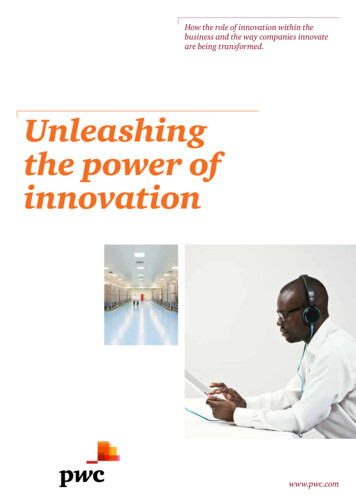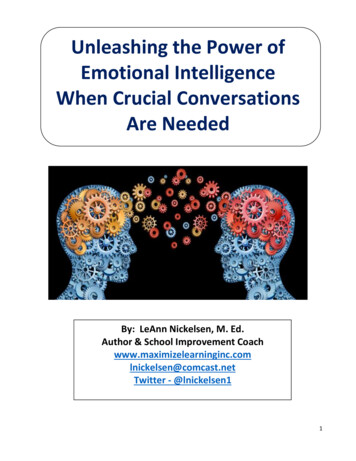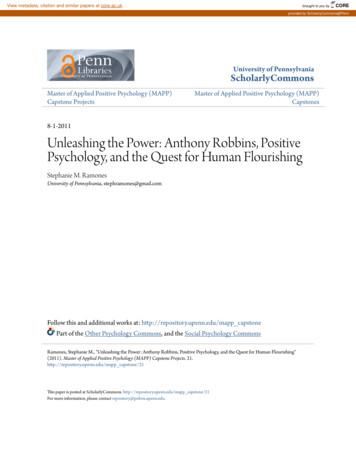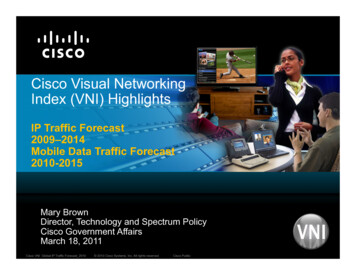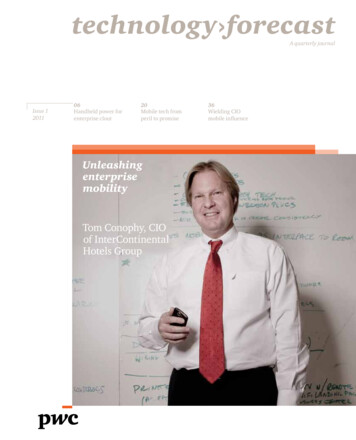
Transcription
technology › forecastA quarterly journalIssue 1201106Handheld power forenterprise clout20Mobile tech fromperil to promiseUnleashingenterprisemobilityTom Conophy, CIOof InterContinentalHotels Group36Wielding CIOmobile influence
›
Contents ›Features ›06Turning handheldpower into enterpriseclout06The smartphones, tablets,and other handheld devicesyour employees already ownare productivity drivers.Seize the opportunity.20Mobile technology’sjourney from perilto promiseApp-centric handhelds arematuring rapidly, and thepath to secure adoption ismore straightforwardthan it may seem.3620How to exert leadershipon enterprise mobilityCIOs need to acknowledgethat the IT capabilities ofemployees’ own smartphonesthreaten the status quo.Interviews ›Departments ›16 Getting to your bestmobile strategy02 AcknowledgmentsTom Conophy ofInterContinental HotelsGroup describes theimportance of a soundcultural and managementfoundation for mobileinnovation.03 Subtext32Blending work andlife on smartphonesTodd Schofield of StandardChartered makes enterpriseapplication platforms fromconsumer smartphones.44Anticipating the nextphase of enterprisemobilitySrini Koushik of Nationwidethinks out loud about howhandhelds are influencingenterprise computingoverall.48The new power of thecybernetic employee36Mark Pesce of FutureStConsulting considers howwork gets done differently inthe new mobile enterprise.04Message from the editor
Acknowledgments ›AdvisoryUS studioIndustry perspectivesSponsor & Technology LeaderTom DeGarmoArt DirectorJacqueline CorlissUS thought leadershipDesignersSuzanne LauDiana LiraDuring the preparation of thispublication, we benefited greatlyfrom interviews and conversationswith the following executives:Partner-in-ChargeTom CrarenCenter for technology& innovationManaging EditorBo ParkerEditorsVinod BayaAlan MorrisonContributorsGalen GrumanLarry MarionBud MathaiselBill RobertsEditorial advisorsLarry BestBrian ButteGary DeloozeTerry RetterJoe TagliaferroChristine WendinCopyeditLea Anne BantsariIllustratorsDonald BernhardtTatiana PechenikPhotographyCover, Jen Rosenstein PhotographyFelipe DupouyCorbisGettyOnlineManaging Director,Online MarketingJack TeuberDesigner and ProducerScott SchmidtReviewersAhmed El AdlPhilip GarlandOliver KodermanTracey RileyMarketingNatalie KontraTom Conophy, CIO, InterContinentalHotels GroupDavid Goldschlag, VP, mobiletechnology, McAfeeChris Hazelton, research director,mobile and wireless, the451Larry Herrmann, manager, global ITcustomer support, DJOEd Jimison, systems engineer, IntelNathan Kelly, VP, global operations & IT,Palm Global Business Unit, HPSrini Koushik, SVP, CTO, and CIO sharedapplications, NationwideSrinivas Krishnamurti, senior director,mobile solutions, VMwareAaron Levie, CEO, Box.netAndi Mann, VP of virtualization productmarketing, CAMark Pesce, founder, FutureSt ConsultingThomas Reid, SVP, Sun Life FinancialSpecial thanks toTodd Schofield, global head, enterprisemobility, Standard CharteredVicky HuffDimpsy TeckchandaniSteve Subar, founder and CEO,Open Kernel LabsKim Woodward, VP of corporatemarketing, Citrix Systems02PwC Technology Forecast 2011 issue 1
Subtext ›Cybernetic eraA change in individuals caused by an informationsystem that is always present and accessible,in which the individuals and the system beginto blend.Autonomy, mastery,and purpose (AMP)Dan Pink’s list of intrinsic motivating factorsfor employees in the 21st century, which contrastswith extrinsic motivating factors such as financialincentives that were more effective in theprevious century.Context-awarecomputingComputing that benefits from human-assisted,sensor-rich mobile handhelds for timely location,personalization, and environmental input.Client virtualizationOn mobile devices, a runtime environment thatmobile applications and their resources can operatein. In the case of thin-client virtualization, all thedata resides on the server, and the mobile devicemerely acts as a display.Native appAn application developed to take advantage of thespecific functionality and interfaces of a device’soperating system.Unleashing enterprise mobility03
Message from the editor ›Tom DeGarmo, Principal & Technology Leaderthomas.p.degarmo@us.pwc.comthey have figured out how to manage applications andinformation on employee-owned devices in a secure way.How did we get here? And why would a company offerto support many different kinds of handhelds?You might think this is just a case of being nice toMillennial employees (those born after 1980). If wedon’t let them have their way, we’ll have to deal witha disgruntled staff, some say.To every thing there is a season. As this verse1 poeticallycaptures, matters that at one point in time seemed settledmay at another time be open again for debate. When itcomes to smart handhelds, this is one of those times.Enterprises are accustomed to standardizing andcontrolling the devices their employees use. But theseason is changing. The relationship of mobile devices toenterprises—more importantly, the relationship of mobiledevices to individuals who also happen to be employees—is undergoing a fundamental transformation. More thanany other factor, the rapid innovation in smart handheldsis responsible for this transformative development.What does this new world look like? Some leading-edgecompanies are saying to new hires, “Bring your ownsmartphone; we’ll support it.” They’re offering 50monthly subsidies and allowing employees to choose thedata plan that works best for them. These companies say1Ecclesiastes 3:104PwC Technology Forecast 2011 issue 1The reality is far more interesting. Yes, Millennialsare likely to be “digital natives” who have strong, evenobsessive, attachments to the handhelds of their ownchoosing. But a broader industry trend is in play. Smarthandheld users now have more choice and hold thepower of the cloud in each device. And that makes allthe difference. When technology converges the way ithas in the desktop and laptop domain, the opportunitiesfor innovative and creative new uses of the technologyare diminished. It is quite rational to standardize, control,and buy in bulk. There’s no upside to flexibility whenchoices and capabilities are limited.In a world of divergent choices, new capabilities, and amore mobile-sensitive Web, control has a big downside.It kills innovation.What makes today’s divergence even more important,though, is its cybernetic quality. It’s the comminglingof the human adjustment to engaging with informationeverywhere, at any time, with anyone, and the rapidinnovation in mobile computing devices. This issue of theTechnology Forecast examines the underpinnings of thesetwin disruptions in the business world. It suggests thatcompanies that are stuck in control mode are beingpenny-wise and pound-foolish. The opportunity here isn’tjust to give the digital natives the shiny new gizmo they’vebeen craving. Smart handhelds imply more opportunitiesfor enterprises than might be obvious at first glance.
The article, “Turning handheld power into enterpriseclout,” on page 06 explores how enterprises can turnwhat has been a consumer trend in smart handhelds totheir advantage. The first step here is to understand howthe workforce is changing. What digital natives are doingwith their handhelds and the information cloud they tapinto represents a different collaboration model—a moreinteractive and information-rich path to productivity.They depend on personalized access to a cloud of relevantinformation. Rather than bucking this trend, businessshould embrace it.This issue also includes interviews with four executivesat companies on the leading edge of smart-handheldmanagement and mobile application development:“Mobile technology’s journey from peril to promise”on page 20 details the ways that security for smarthandhelds is improving. As information becomes morepervasive and easily accessible, the potential to mixenterprise and personal information increases. Controlover corporate data on mobile handhelds is a majorconcern, but security models to manage this data arealready established, and mobile device managementsoftware and major operating systems are evolving toembrace and extend those models. Some of the moreinnovative enterprises have taken advantage of the securitythat already exists and, seeing the potential for processand productivity improvement, have committed themselvesto in-house mobile application development. For themand for others, now is the time to explore the new processimprovement paradigm that’s emerging in smarthandheld applications. Srini Koushik of Nationwide describes how to beginsupporting employee-owned smart handhelds and thevalue of “bring your own device” from an insurer’s pointof view.“How to exert leadership on enterprise mobility” onpage 36 establishes that, as a first step, CIOs need toacknowledge that employees have their own IT capabilitiesnow. Whether by conveying an understanding of the devicechoice options to the rest of the C-suite, establishing newgovernance approaches, or formulating new businessprocess models, CIOs have ample opportunity to lead,especially considering the new power of smart handheldsconnected to the cloud. Otherwise, someone else will. Tom Conophy of InterContinental Hotels Group placessmart-handheld trends in the context of an innovativeIT culture he’s established and led. Todd Schofield of Standard Chartered outlinesthe bank’s strategy for supporting smart handheldsand building an application development organizationto support that strategy. Mark Pesce of FutureSt Consulting paints a big-pictureview of how organizations can face the challenges ofpersonal IT, as well as a view of the leading mobileapplication development trends.Please visit pwc.com/techforecast to find these articlesand other issues of the Technology Forecast online.If you would like to receive future issues of this quarterlypublication as a PDF attachment, you can sign up atpwc.com/techforecast/subscribe.We welcome your feedback and your ideas for futureresearch and analysis topics to cover.Tom DeGarmo, PrincipalTechnology LeaderUnleashing enterprise mobility05
06PwC Technology Forecast 2011 issue 1
Turning handheld power intoenterprise cloutThe smartphones, tablets, and other handheld devices your employeesalready own are productivity drivers. Seize the opportunity.By Bo Parker and Alan Morrison›D7, a construction consulting firm in Southern California,threw its hat in the ring when it heard that Box.net, a cloudstorage provider, was seeking a partner to test businessapplications on the Apple iPad. Before long, about 20 fieldworkers at D7 were using smart tablets to diagnose qualityassurance issues on-site; to relay audio, documents, anddigital photos; and to store and share the material via Box.net.By using this approach, D7 has accomplished somethingthat had previously eluded it: digital workflow fromcustomer sites. In the past, workflow involved paperdocuments “that weren’t very usable,” says Aaron Levie,CEO of cloud collaboration company Box.net. JosephDaniels, D7 president, says tasks that took a week orlonger can now be done the same day. “That’s whatpeople want. They want it now or yesterday,” he says.With a mobile digital workflow, the D7 team eliminateda major bottleneck.1This modest example illustrates several trends relatedto enterprise mobility that PwC has identified for thisissue of the Technology Forecast. Among them:1Ian Hamilton, “Construction firm tests iPads: Company pairs cloud software with Apple tabletto try to boost productivity,” The Orange County Register, July 16, 2010, Factiva DocumentOCR0000020100717e67g0001h; Mike Schramm, “Box.net’s 20 iPads arrive at D7Consulting,” The Unofficial Apple Weblog (TUAW), e-at-d7-consulting/; PwC interview with Box.net CEO Aaron Levie,August 18, 2010; and “Box.net’s iPad campaign: Real-world tests,” Box.net YouTube video,http://www.youtube.com/watch?v YzQZmzFZ1UM, accessed October 7, 2010. By using smart handhelds and the cloud, employees canimprove business processes in ways they couldn’t before. Consumer-grade tablets, smartphones, and supportingtechnologies are more powerful than ever and are nowbecoming secure and reliable enough for enterprise use. Applications don’t need to be sophisticated to produceimmediate business results. With the help of mobility, the knowledge economy isexpanding to include more traditional industries.Enterprise mobility is clearly a growing resource forenterprise agility, giving organizations access not only tostandard cell phone communications, but also to wideranging collaboration capabilities at low cost. Many of thenewest mobile applications are relatively simple, but thecollaboration they enable is at a higher, more complexlevel, because it cuts across organizational boundaries.Yet this new resource presents a challenge unfamiliar tobusiness executives who are accustomed to controllingenterprise technology: how do you take advantage ofan asset that most of your employees already have intheir pockets?Unleashing enterprise mobility07
The answer to that question has manylayers. It requires an understanding ofwhat drives knowledge workers—especially Millennials, those digitalnatives born after 1980—and ofthe implications for attracting andretaining talent. It involves innovativeorganizational change to manage theflat, sprawling network of individualnodes defined by workers and theirdevices. And it requires moreimaginative uses of IT resources,sourced internally and externally, tomove closer to where the action is—theedge of the enterprise—and to deliverapplication and information powerthat’s been elusive until recently. Thisfirst article examines the businessimplications of these issues.The article, “Mobile technology’sjourney from peril to promise,” onpage 20 examines the issues ofapplication development, the limits ofthese devices in replacing PCs, and thesecurity risks of handhelds—whichturn out to be not as insurmountableas many say. The article, “How toexert leadership on enterprisemobility,” on page 36 offers insightinto governance and other risks.At this stage of enterprise mobility,the biggest risk for many companieswould be inaction.A phone in your pocket, or anenterprise IT asset?Knowledge workers want nothingless than perpetual connection tothe information they need, andtoday more of that information isincreasingly accessible via handhelds.The smartest of these devices, asfuturist and interactive mediaconsultant Mark Pesce points out,offer the same power as a 1980s Craysupercomputer2 and are optimizedto work on wireless networks suitedto high-volume data exchange.Smartphone subscribers account formore than 60 percent of US mobileapplication use and more than 55percent of mobile Web browser use,according to comScore.3 Earlyadopters are using their phones tobecome an integrated part of theinformation landscape. This is thebeginning of the realization of acybernetic vision in which humans23See the interview with Mark Pesce on page 48.“Smartphone Subscribers Now Comprise Majority ofMobile Browser and Application Users in U.S.,”comScore press release, October 1, 2010, http://www.comscore.com/Press Events/Press Releases/2010/10/Smartphone Subscribers Now Comprise Majority ofMobile Browser and Application Users in U.S,accessed October 5, 2010.and their devices, wherever they are,are part of a more integrated whole.As Figure 1 points out, traditionalknowledge management hearkensback to an era in which the enterpriseinformation system was all that wasonline. Employees had access to onlyinternal IT resources. Now, in the eraof the smart handheld, employeeshave anytime access to externalresources. Not only that, but thoseresources change in response to anemployee’s input. As information inthe cloud becomes more adaptive, theresult will be a cybernetic system, asymbiosis, and an interworking ofman and machine that’s been theoryfor a long time but is now finallybecoming reality.The new smartphones and tabletstake advantage of new classes ofapplications that allow easier use ofknowledge and information sourceson the public Web. The best of theseapplications can improve processesincrementally in areas such as fieldsupport and sales with the help ofsmall, agile collaboration tools suitedto the new handhelds. What hasemerged is a form of cloud-basedcollaboration and file sharing thatemphasizes ease of use rather thanexpansive feature sets.Figure 1: The trend in cybernetic employeesInteractionthroughdevices riseKMEmployeeEnterpriseKMPC era08PwC Technology Forecast 2011 issue 1TodayEnterpriseKMFutureTraditional approaches to knowledgemanagement (KM) surround the employeewith corporate information. Smart handheldssimplify access to external information andfeed real-time context to the system. Thesystem uses that input to filter what itretrieves for the employee.The employee moves more to the edge inthis scenario, straddling the boundarybetween internal and external information.
Few IT departments are currently inthe decision loop for acquiring themobile devices and applications forenterprise use. When IT departmentsare in the loop, they clear a path forsales forces and other knowledgeworkers to use leading-edgesmartphones and tablets. “When theCEO shows up with an iPad, you [theCIO] are forced to look at it whetheryou want to or not,” says LarryHerrmann, manager of global ITcustomer support at DJO, a medicaldevice manufacturer. Herrmanncompares the current trend to whathappened with BlackBerry devices inthe mid-2000s. “We got our firstBlackBerry devices about six or sevenyears ago, and the CEO at that timesaid there will never be more than 25.Now we’ve topped 900 globally.”Too often, though, IT is slow tocapitalize on the mobility opportunity.And as a result, individual executives,business units, and employees dowhat they want with smart handheldsand the myriad mobile applicationsavailable in the cloud. The individualresults may be useful, but a potentiallypowerful enterprise IT asset is not yetbeing tapped organization-wide.Some IT organizations are building onrecent technology improvements torefine efforts they had already started.“We are sought after by the businessand are viewed as consultants,” saysTom Conophy, CIO of InterContinentalHotels Group (IHG). “We profess theart of the possible.” His team offeredmobile applications in the past and isenthusiastic about capabilities thatbegan to appear at the end of thedecade. “IHG was one of the firstcompanies to actually put out a mobileapp that did booking, but it was prettylame,” he admits.Figure 2: Smart handhelds enable cybernetic systemsConophy’s point: The technologyhas only recently become enterpriseready. “The phones themselves werenot that great, and the infrastructurewas lacking,” he says. “The renderingcapabilities were not super.” Conophydescribes the current environmentas “a perfect storm.” After laggingfor years, more of the capabilitiesIHG and others need have atlast materialized.Smart worker, smart devicesymbiosisMobile phones aren’t just morepowerful; broadband connectivity,3-D sensors, and enhancedgeolocation capability have turnedthe devices into intelligent, humanassisted network nodes on the t alwaysthere as workis happening?Web. (See Figure 2 for a comparisonof network intelligence betweenlaptops and smart handhelds.) Thesymbiosis mentioned earlier happenswith the help of a constant flowbetween these nodes and thechanging information in the cloud.Blend that capability with socialnetworking, and you get an emergingform of large-scale, contextuallyaware mobile networking that manyenterprises have dreamed of—thekind that research and development(R&D) labs such as the Palo AltoResearch Center (PARC) are exploring.44See a description of PARC’s focus area “Context-awarecomputing & mobile interaction” at ess/, accessed October27, 2010.SMARTHANDHELDSHighpersonalizationMuch morefrequentusageAlwaysaccessibleNSFewer sensors and contextCONNECTEDWORKSTATION Many more sensors and contextINTELLIGENTNETWORK NODESmart handhelds provide features that laptops do not, including quick, always-on accessto applications and a multitude of sensors. The result is that a human with a smartphoneor tablet becomes a de facto human-assisted network node—part of a cybernetic systemand the overall information flow.Unleashing enterprise mobility09
The art of the possible in enterprise mobility in the 2010sWhat is an “intelligent network node”and why is it important to enterprisemobility? An intelligent node isbasically Nova Spivack’s “human assensor” concept, with each humancarrying and interacting on theWeb via a smartphone filled with aGlobal Positioning System (GPS),sensors, a powerful processor, andlots of memory.* These nodes and thenetworking that connects them createthe opportunity for applications tolearn more about you and others inyour business network in real time andprovide more of the information youneed in your context at the moment.For example, a salesman about tovisit a prospect’s headquarters officecan learn about mutual friends andconnections before walking in thedoor. Some of the main enablersfor this kind of contextually awarecomputing include the following:Better locating capability:Smartphones and cellular networksthat are GPS enabled are more preciseabout location these days. Togetherwith other sensors and details abouteach person, applications will be ableto make educated guesses about whatinformation will be relevant.More capable sensors: Smartphonesalready have sensors that detectmotion. That’s how Apple iPhonedevices can have displays that respondto the device tilting, or games thattake advantage of the phones’ motiondetection capabilities and build thatinto a user interface. New barometersin phones will add to motion detectionand geolocating capabilities, makingit possible for applications to learnwhat floor a person is on in a building,tell them someone they know is in a*Nova Spivack, “Nowism,” TTI Vanguard Shifts Happenconference, San Francisco, CA, February 23, 2010.10PwC Technology Forecast 2011 issue 1meeting down the hall, or indicatewhat printer is closest to them.Faster networking: 3G is finallycommonplace, although the averagespeeds US users experience on mobiledevices are sometimes as low asone-quarter of the average speedsadvertised, according to the FederalCommunications Commission (FCC).This implies downloads in less thanoptimal circumstances of 100 to 500Kbps or lower. In the best conditions,users get from 1 to 1.5 Mbps in theUnited States. Network upgrades(to the Long-Term Evolution [LTE]standard, for example) promiseimprovements two or three timeswhat users are experiencing with3G. That’s network throughput. Onthe data throughput side, back-endstorage system speeds are improvingsubstantially, with higher-speed solidstate storage becoming available andcaching performed more cleverly nowthan ever. Overall, users experiencebetter performance than they didthree years ago, and they can expectan additional cycle of improvementto occur during this decade.During the next three to five years,intense development activity andexperimentation will continue.Look for lots of targeted applicationsintended to solve practical problems.The end result will be a differentkind of application environment forenterprises—one where businessunits are more closely involved indevelopment or even doing somedevelopment themselves, not tomention a rich but rather confusingand difficult-to-navigate applicationenvironment externally. The firstfew years will be a time to focuson the fundamentals and to capturewhat’s most essential from anapplication perspective.The problem for the enterprise isthat adoption of this powerful butunfamiliar networking capabilityis happening on the consumer Weband then bleeding over into theenterprise. Enterprises are havingdifficulty deciding what to allowand what to curtail. They also needsubstantial organizational flexibility totake advantage of this new capability.Remnants of command-and-controlor even carrot-and-stick approaches,which exist in many organizations,are not supportive of this capability.Because the idea of participating inthe cloud is so compelling, manycompanies are conducting pilotprojects and pondering what policiesthey might need to change, but theyhaven’t gone much further. Othersthat have managed some degree ofcomfort in a somewhat more flexibleorganizational structure haveembraced the new medium.It’s not just organizations that arechanging; the individuals in themare changing, too, especially theyounger, more adaptive generations.It’s not news that the workforce haschanged in response to technologicalimprovements, but it’s worth ponderingwhat specific changes have resulted.Take manufacturing as an example.Factory output per worker inindustrialized countries has risendramatically since the 1970s. Thisproductivity boost is a primary factorbehind factory employment declines.5The need for fewer workers inindustries that previously requiredmore physical labor is one of thereasons today’s economy ischaracterized as a knowledge economy.A significant share of that increasedproductivity is due to the improvedability to generate, retain, share,and—most importantly—leverageinformation. More workers will do5Jay Bryson and Tim Quinlan, What Really Drives Growthin the Industrial Sector? Wells Fargo Fixed IncomeResearch, July 2010, rch/special rJuly2010.pdf, accessed October 5, 2010.
more knowledge work, even if theirjob category remains otherwisesteady and stable.Handhelds are becoming powerfulat precisely the same time that theknowledge economy is becomingpredominant. One implication:enterprises must make more roomfor the creative nature of a handheldwielding workforce. This is especiallytrue in an environment that requiresenterprise agility.Enterprise agility’s demandfor workforce creativityThe most knowledge-intensivesegments of the workforce alreadyunderstand the value of fosteringcreativity in this new environment.Standard Chartered, for instance,is setting up a mobile applicationsdevelopment unit that emulates aSilicon Valley startup, to the pointthat it is located in San Francisco’sSouth of Market new media districtand staffed by a small group of locals.Never mind that Standard Chartered isheadquartered in London and most ofits branches are in Asia, Africa, andthe Middle East. Todd Schofield, whoheads the unit, says the idea is “to stayvery small and nimble, and be able tobring in new ideas, deliver quickly,and then move on to the next thing.”6The unit’s approach reflects the waydigital natives tend to operate andunderscores why they are capableof contributing to enterprise agility.Because they are accustomed to thetools that allow agility, digital nativesare more apt to iterate quickly and tocontinually refine their access toinformation via handhelds. Andbecause they collaborate so readily onan ad hoc basis, they’re accustomed toparticipating in change efforts—anaspect of their character that enterprisesneed to take greater advantage of.767See the interview with Todd Schofield on page 32.See Michael S. Hopkins, “The Digital Natives, and You,”MIT Sloan Management Review, April 1, 2010, 010/spring/51317/the-digital-natives-and-you/, accessedOctober 27, 2010.Several companies interviewed forthis issue focus on smartphone andtablet innovation precisely becauseof the growing influence of digitalnatives. Their development groupsexemplify how the workforce as awhole is changing in response to theneed for accelerated innovation. IHG’sConophy has set up informal R&Dgroups to hash out ideas. “You haveto give people outlets,” he says. “Theyhave their day jobs, and then theyhave their passions. The idea is to tryto turn on some of those passions.”8In job categories where workerstraditionally have used their hands(construction trades, for example),the information component isincreasing and more creativeapproaches are emerging. Asconstruction tools and techniques8See the interview with Tom Conophy on page 16.become more sophisticated (asin the D7 example) and the needfor precision increases, more effortshifts to planning, measuring,calculating, resourcing, machinesetup, maintenance, and qualitycontrol, where each worker nowhas management responsibility andautonomy over an important partof what can be, in essence, a small,ad hoc, on-site building factory.That’s because the iPad, the iPhone,Android-based handhelds, and similardevices have opened up a newcategory of interaction with digitalcontent for companies such as D7.Before, that interaction essentiallywas limited to content creation (witha desktop or a laptop) or consumption(also with a laptop, but more recentlywith a smartphone or an e-reader).Now, a category for engagement hasemerged. (See Figure 3.)Figure 3: The role of new mobile handhelds in engaging with contentHighdegree onesLowdegree offunctionalityFeaturephones ande-readersConsumptionEngagementCreationDegree of interactionContent engagement splits the difference between creation (which requires a precise andelaborate interface, such as a mouse and keyboard) and consumption (which requires only asimple interface). Multi-touch and gesture interfaces on smart handhelds allow new ways tointeract with the content, and that level of interaction should increase as developers becomemore familiar with the capabilities of these relatively new interfaces.Unleashing enterprise mobility11
Sun Life Financial Canada is close torolling out a new application to runon the forthcoming Research InMotion (RIM) PlayBook tablet thatcould be descri
cultural and management foundation for mobile innovation. 32 Blending work and life on smartphones Todd Schofield of Standard Chartered makes enterprise application platforms from consumer smartphones. 44 Anticipating the next phase of enterprise mobility Srini Koushik of Nationwide thinks out loud about how handhelds are influencing




